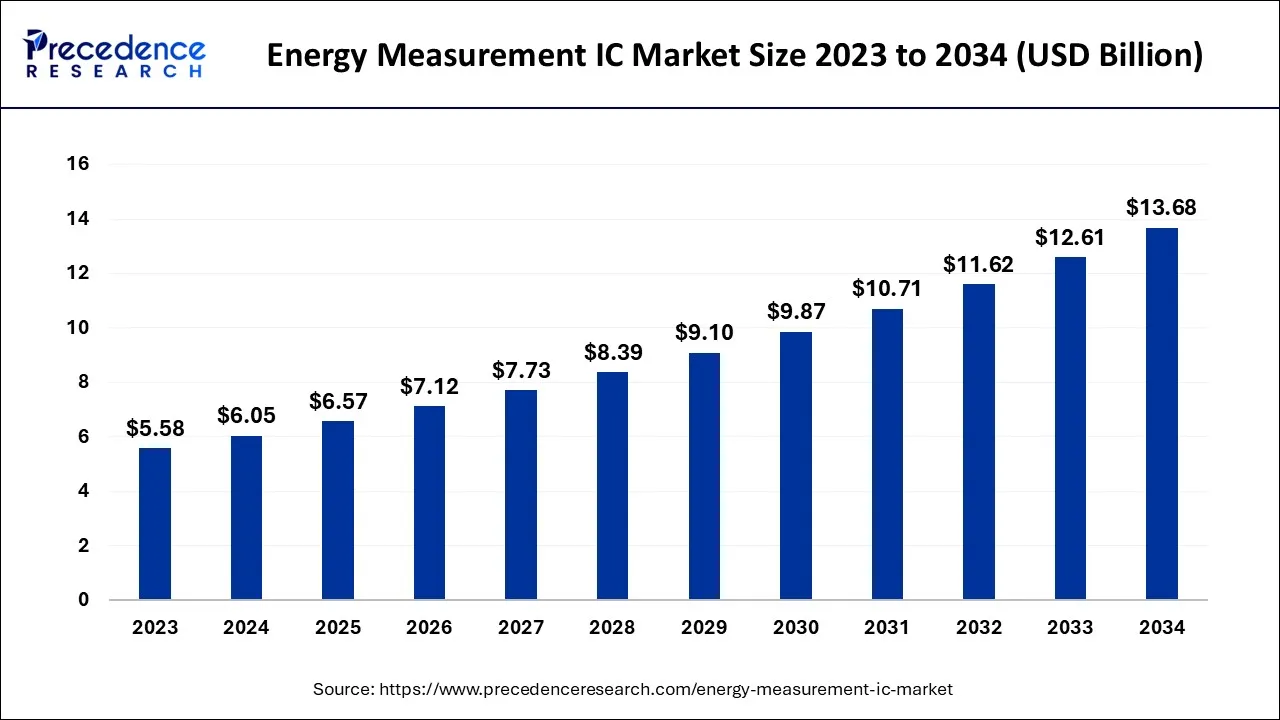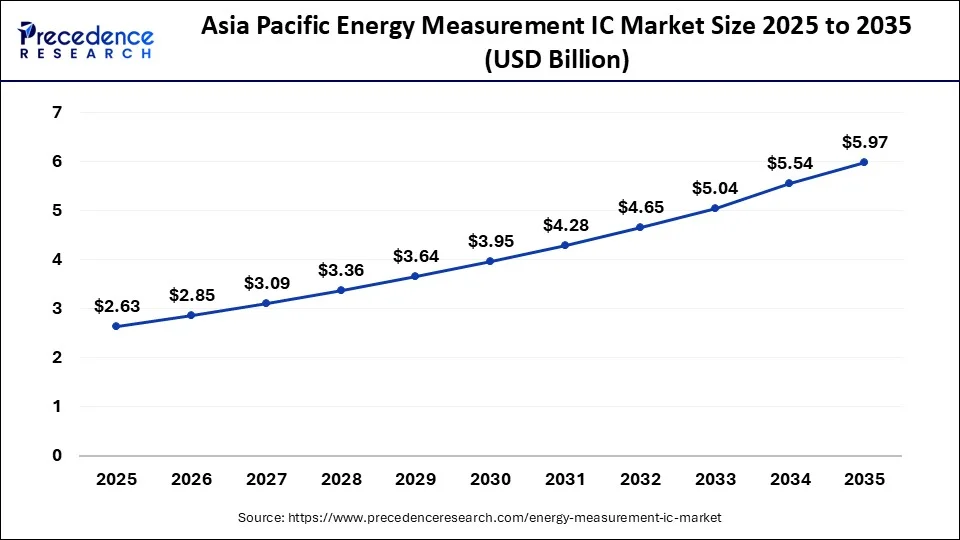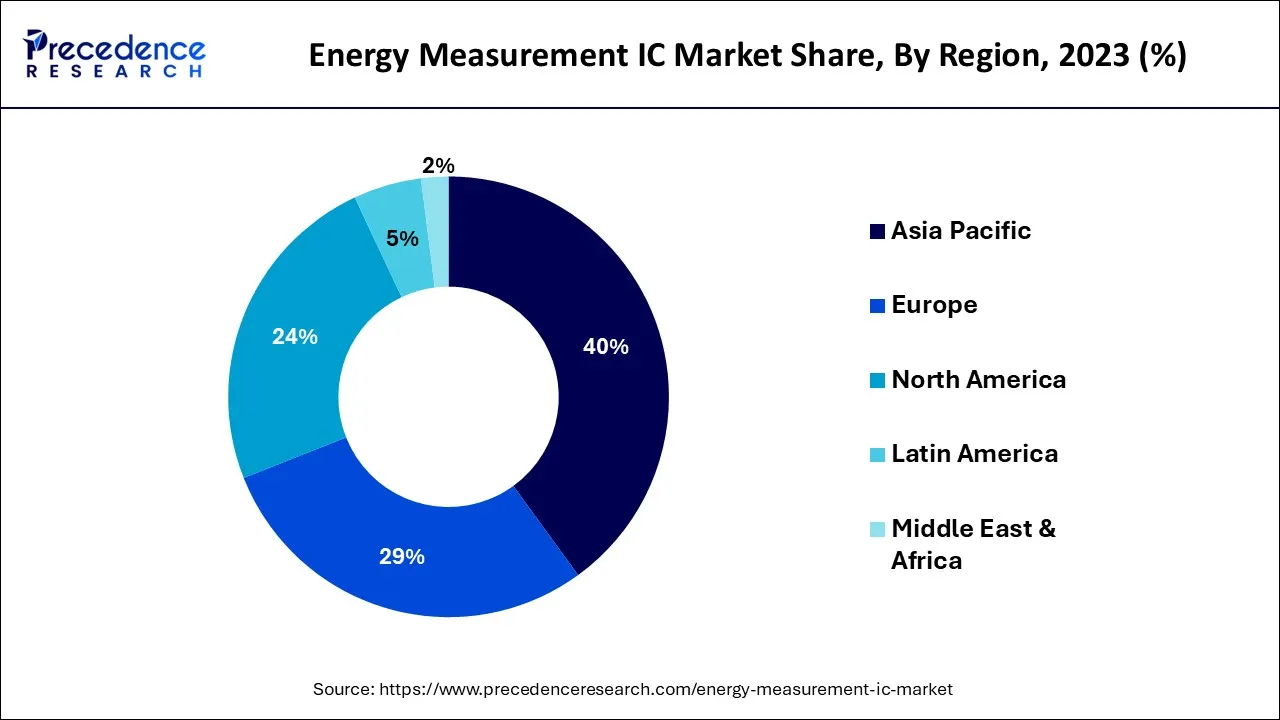What is the Energy Measurement IC Market Size?
The global energy measurement IC market size is calculated at USD 6.57 billion in 2025 and is predicted to increase from USD 7.12 billion in 2026 to approximately USD 14.70 billion by 2035, expanding at a CAGR of8.39% from 2026 to 2035.

Energy Measurement IC Market Key Takeaways
- Asia Pacific generated more than 40% of the revenue share in 2025.
- By Phase, the polyphase market segment is expected to record the maximum market share between 2026 to 2035.
- By Application, the solar inverters segment is predicted to contribute the largest market share and is expected to expand at the fastest CAGR between 2026 to 2035.
Market Overview
Energy measurement is the measuring of energy usage that is used to gauge customer demand and aid in improved energy management. Modern energy measurement technology has led to the replacement of traditional utility meters. Intelligent management is becoming more and more necessary as the demand for high-precision electrical metres from various applications, such as the commercial or manufacturing industries, rises. It has become more necessary for energy calculation ICs to be intelligent enough to calculate the whole amount of electrical power used.
Energy Measurement IC Market Growth Factors
Rising levels of investment in the development and innovation of energy measurement technology, rising levels of demand for high accuracy electric metres from a variety of applications, including commercial and manufacturing industries, rising adoption of smart appliances, rising numbers of government regulations for energy use, and rising preferences for the use of smart meters, which record electric energy consumption and transmit the information to the supplier.
On the other hand, rising trends in energy measurement to calculate reactive energy measurement, power quality monitoring, and multi-tariff billing along with increasing adoption of new and advanced technologies that offer various features in energy metres including measurement and monitoring will further contribute by generating massive opportunities that will lead to the growth of the active energy measurement integrated circuits (ICs) market in the aforementioned.
Market Scope
| Report Coverage | Details |
| Market Size in 2025 | USD 6.57 Billion |
| Market Size in 2026 | USD 7.12 Billion |
| Market Size by 2035 | USD 14.70 Billion |
| Growth Rate from 2026 to 2035 | CAGR of 8.39% |
| Largest Market | Asia Pacific |
| Base Year | 2025 |
| Forecast Period | 2026 to 2035 |
| Segments Covered | Phase, Application, and Region |
| Regions Covered | North America, Europe, Asia-Pacific, Latin America, and Middle East & Africa |
Market Dynamics
Driver
Growth advancements in smart electricity meters driving the global energy measurement ic market
Through the incorporation of renewable energy sources like wind and solar, the energy sector has advanced technologically. Among the new issues for the energy sector are the bidirectional flow of energy, intermittent generation from renewable sources, unequal distribution of electrical power, and noise pollution on power lines. The resilience of the network may be impacted by these difficulties. In order to ensure continuous and high-quality service to end customers, energy distribution companies are deploying smart metres to enable real-time network diagnostics and quick issue diagnosis. This is stimulating the global market for smart plugs and meters.
A smart electricity meter can track electricity use and gather data on the calibre of the power being supplied, making it a crucial component of the energy distribution network. For instance, it can measure frequency fluctuations, reactive energy, total harmonic distortion, harmonic content, and voltage transients and surges. Smart metres can track the health of the meter, do away with the need for intervention in times of true failure, and stop fraud.
The highest precision can be achieved by using energy metering ICs to measure active energy (kWh), apparent energy (KVA), reactive energy (KVAR), RMS, and power quality in single phase and polyphase revenue meters. Thus, the increased use of smart meters is fueling the growth of the energy-measuring IC industry.
Restraint
High cost
The cost of manufacturing and purchasing energy measurement ICs is one of the primary restraints the market is facing. These ICs are intricate electronic components that demand specialised manufacturing techniques and supplies, which raises the cost of production. Additionally, the design and development of these ICs frequently necessitate a sizable expenditure in R&D, which might raise the entire cost of the goods. Energy measuring ICs may not be as affordable for smaller businesses and consumers, which may reduce the market potential for these goods.
As a result, larger organisations with more substantial resources have played a major role in driving the adoption of energy measurement ICs. The price of energy measuring ICs can be impacted by market demand and competition in addition to manufacturing expenses. Due to the lack of competition, costs may continue to be high as the market for energy measuring ICs is still quite tiny.
The market may grow more competitive as more businesses enter it, though, increasing the availability of energy measurement ICs to a wider spectrum of consumers. Furthermore, the high price of energy measurement ICs may prevent their use in developing nations where cost sensitivity is crucial.
Opportunity
Growing need for energy-efficient solutions
The market for energy measurement ICs is presented with a sizable potential by the growing need for energy-efficient solutions. Energy-efficient solutions can assist in reducing energy usage, which is advantageous for the environment and for lowering consumer energy prices. By providing precise measurement and monitoring of energy usage, energy measurement ICs play a significant role in enabling the development and deployment of energy-efficient systems.
The market for energy measuring integrated circuits (ICs) is anticipated to rise as governments and organizations around the world embrace laws and efforts targeted at lowering energy consumption. For instance, the Energy Efficiency Directive in the European Union mandates that member states achieve energy savings of 32.5% by 2030. The US Department of Energy has similarly set a target of a 30% energy usage reduction by 2025. Demand for energy-measuring ICs is also anticipated to rise as smart home technology and the Internet of Things (IoT) become more widely used.
Energy monitoring ICs can assist in tracking energy usage and offering insights into prospects for energy-saving measures as a result of the increasing number of connected devices in homes and companies. Demand response systems, which can assist utilities in managing peak demand and preventing energy waste, can also be developed with the aid of energy measurement ICs.
Energy measuring ICs have a chance due to the rising use of renewable energy sources like solar and wind power. Energy measurement ICs can assist in ensuring accurate measurement and monitoring of energy output and consumption as renewable energy sources become more prevalent. This knowledge is essential for maximizing the use of renewable energy sources and making sure that there is a steady and reliable supply of energy.
Segment Insights
Phase Insights
The worldwide energy measurement IC market has been divided into single phase and polyphase categories based on phase. In 2023, the polyphase market category accounted for a maximum share of the overall market. It is the market for energy measurement IC that is expanding the fastest. A polyphase system consists of two or more voltages that have the same amplitude and frequency and are offset from one another by an equal electrical angle. Electricity metres with several phases are frequently used in commercial and industrial settings.
Energy measuring ICs for polyphase metres provide utility businesses with unrivalled digital precision and dependability as well as a configurable platform. As a result, utilities find it simpler to provide their sophisticated automated metre reading (AMR) systems to their low- and mid-tier commercial customers.
Application Insights
The smart plug, energy meter, solar inverter, smart power distribution units (PDU), street lighting, EV charger wall boxes and other application segments make up the worldwide energy measurement IC market. In 2023, the solar inverters market share was dominant. Throughout the forecast period, it is anticipated to increase at the fastest CAGR.
The environment and energy security are being negatively impacted by a significant growth in energy usage. The need for alternative energy sources like solar has been growing as a result. In solar energy networks, smart energy metres are crucial. Utility companies and end users can communicate with smart energy meters to exchange specific information about how energy is used and the state of the energy network. They can also gauge the flow of energy. Energy conservation Smart metre ICs can be utilised for applications like energy demand management and grid-connected distributed photovoltaic power cabinet power monitoring.
Regional Insights
What is the Asia Pacific Energy Measurement IC Market Size?
The Asia Pacific energy measurement IC market size is exhibited at USD 2.63 billion in 2025 and is projected to be worth around USD 5.97 billion by 2035, growing at a CAGR of 8.54% from 2026 to 2035.

Due to the presence of major industry players and technological breakthroughs, Asia Pacific held the highest share of the worldwide energy measurement IC market in 2023. Energy measuring IC producers have significant potential in China, India, and Japan. China has the biggest amount of smart meter installations, which helps it to dominate the industry in the Asia Pacific. The nation is making large investments in the electrical grid industry. Between 2021 and 2025, it intends to invest around US$ 896 billion in electricity growing due to increased investment in smart grid and smart city initiatives, as well as an increase in data centres and IT hubs.

India Market Analysis
India's energy measurement IC market is experiencing growth due to increasing power consumption, rapid urbanization, and expanding industrial and commercial sectors. Government initiatives like smart metering programs, grid modernization, and efforts to reduce power losses are driving demand. Additionally, the rising focus on energy efficiency, accurate billing, and the widespread adoption of advanced digital meters by utilities further support market expansion during the forecast period.
What Drives the European Energy Measurement IC Market?
The European market is expected to grow at the fastest CAGR in the upcoming period due to widespread smart meter rollouts, stringent energy efficiency regulations, and a strong focus on grid modernization. Growing renewable energy integration, rising demand for precise energy monitoring in residential, commercial, and industrial sectors, and supportive government policies further accelerate the adoption of advanced energy measurement ICs across the region.
UK Market Analysis
The UK energy measurement IC market is growing due to large-scale smart meter deployment, rising focus on energy efficiency, and ongoing grid modernization initiatives. Increasing adoption of renewable energy sources and demand for accurate power monitoring in residential and commercial sectors support growth. Government policies promoting smart grids, carbon reduction, and digital utility infrastructure further drive market expansion.
What Makes North America a Significant Region in the Energy Measurement IC Market
North America is considered a significant market due to the surge in electric vehicle charging infrastructure, expansion of data centers, and increasing use of distributed energy resources. Rising adoption of advanced power analytics, strict compliance requirements for metering accuracy, and investments by utilities in real-time monitoring technologies further contribute to sustained market growth during the forecast period.
U.S. Market Analysis
The U.S. energy measurement IC market is expected to grow significantly, driven by rising investments in grid resilience, the expansion of electric vehicle charging networks, and the growth of data centers. The increasing adoption of advanced metering solutions for real-time energy analytics, compliance with stringent accuracy standards, and higher demand for power monitoring in industrial and commercial facilities further contribute to market growth during the forecast period.
Value Chain Analysis
- Raw Material Procurement
In this stage, key components such as sensors, microcontrollers, analog-to-digital converters (ADC), and power management ICs are sourced.
Key players: Texas Instruments, STMicroelectronics, Shenzhen Heliwei, Shanghai Belling, Analog Devices, Infineon Technologies. - Wafer Fabrication
Energy measurement ICs are fabricated via complex semiconductor processes, creating transistors, resistors, and capacitors on silicon in cleanroom environments.
Key players: Analog Devices, Infineon Technologies, Microchip Technology, Maxim Integrated, Rohm Semiconductor, NXP Semiconductors. - Photolithography and Etching
Photolithography and etching pattern multi-layer circuits on silicon wafers, forming billions of transistors and interconnections in energy measurement ICs.
Key players: ON Semiconductor, Renesas Electronics, Broadcom, Cypress Semiconductor, SK Hynix, GlobalFoundries.
Energy Measurement IC Market Companies
- Shenzhen Heliwei Technology Co., Ltd.: Develops energy metering ICs and smart power sensing solutions used in smart sockets, home energy management, and IoT power monitoring applications.
- Shanghai Belling Corp., Ltd.: Supplies energy measurement, power management, and signal chain ICs for smart meters, industrial control, IoT devices, and energy-efficient electronic systems.
- Texas Instruments Incorporated: Global semiconductor leader designing analog, embedded processing, power management, and sensing ICs for industrial, automotive, communications, and consumer electronics applications.
- STMicroelectronics N.V.: Offers a broad semiconductor portfolio including microcontrollers, power devices, sensors, and analog/digital ICs for automotive, industrial, IoT, and consumer markets.
Other Major Key Players
- Arch Meter Corporation
- Analog Devices, Inc.
- Microchip Technology Inc.
- Cirrus Logic, Inc.
- Renesas Electronics Corporation
- NXP Semiconductors N.V.
Recent Developments
- Cirrus Logic, Inc. and Lion Semiconductor, based in California, agreed to a contract in July 2021 to buy each other for US$ 335 million in cash. For tasks that use little power and quick battery charging, Lion Semiconductor creates power and management ICs. Cirrus Logic, Inc. will have the chance to increase its mixed-signal capabilities in new markets and promote innovation in sectors like the power industry as a result of the acquisition of Lion Semiconductor.
- The energy metering IC ADE9153A with auto-calibration capability for single-phase energy measuring applications was introduced by Analog Devices, Inc. (ADI) in July 2018.
- In April 2025, Asahi Kasei Microdevices and Silicon Austria Labs validated coreless Hall sensors for EV inverters, advancing the EZ232L toward commercial production.
(Source: www.asahi-kasei.com - In March 2025, Texas Instruments (TI) launched the TPS1685 48 V hot-swap eFuse with integrated GaN technology, delivering 98% efficiency for AI data-center power rails.
(Source: www.ti.com/about-ti
Segments Covered in the Report
By Phase
- Single Phase
- Poly Phase
By Application
- Smart-Plugs
- Energy Meters
- Solar Inverters
- Smart Power Distribution Units
- Street Lighting
- EV Charger Wall Boxes
- Others
By Geography
- North America
- Europe
- Asia-Pacific
- Latin America
- Middle East and Africa
For inquiries regarding discounts, bulk purchases, or customization requests, please contact us at sales@precedenceresearch.com
Frequently Asked Questions
Ask For Sample
No cookie-cutter, only authentic analysis – take the 1st step to become a Precedence Research client




 sales@precedenceresearch.com
sales@precedenceresearch.com
 +1 804-441-9344
+1 804-441-9344